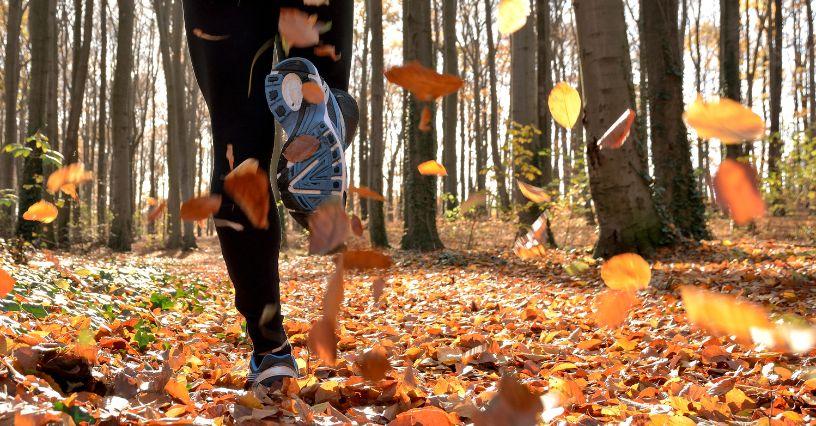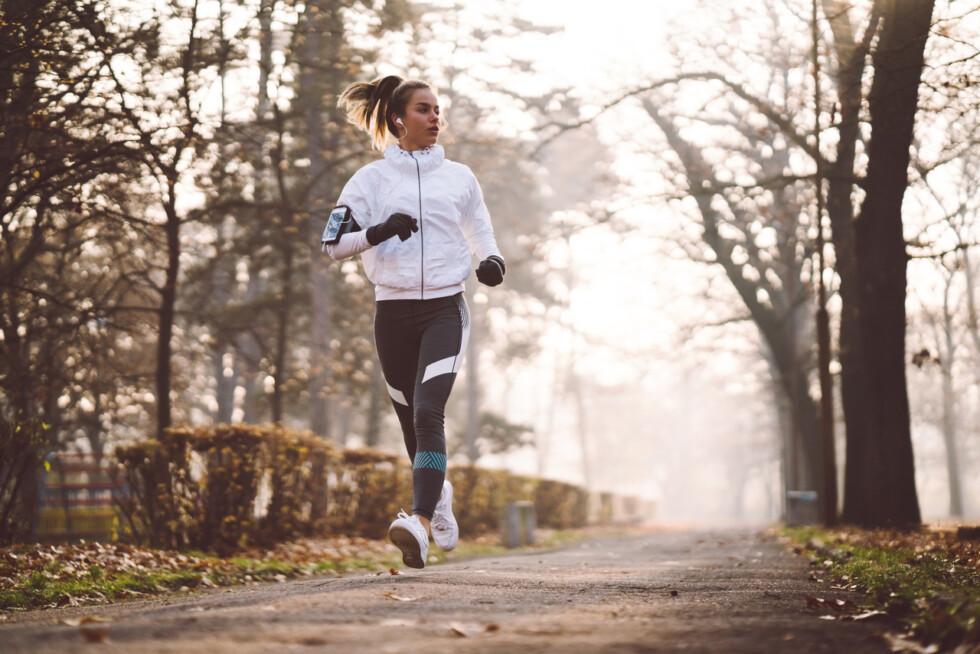In order for autumn running to be pleasant, satisfying and bring many benefits for physical and mental health even in capricious weather, you need to take care of the appropriate equipment that will protect you from wind, rain and low temperature.
Thanks to it, you will avoid uncomfortable situations and maintain a high level of motivation for exercise. In this guide, we’ll talk about how to dress appropriately for fall running training, to keep your body warm and dry, but also how to adapt your equipment for changing weather conditions.
Autumn running – why is it worth starting running training at this time of the year?
Starting your running adventure in the fall can help you maintain a healthy lifestyle, during the period when we are usually much more exposed to spending time indoors, and can also be a perfect motivation to continue outdoor activity during the winter.
The autumn air is much lighter than the summer air, which makes running much more pleasant and beneficial for health. Low temperatures make breathing easier and prevent overheating, thanks to which you can run more efficiently.
When the temperature drops, your body doesn’t have to work as hard to pump blood, so you use up less energy running at the same pace.
If you plan to run middle or long distance races in the spring or summer, fall is the ideal time to start training and building your condition.
In addition to these, autumn is also the time when countless running events are organized, such as marathons or half-marathons. Starting training now can be a step towards participating in such events in the future.
Many popular running trails and parks are less crowded in the fall than in the summer, meaning you can avoid the crowds and enjoy a quiet workout. In addition, running in a picturesque natural environment is an exceptional way to reduce stress, improve your mood and fight the so-called autumn depression, which results from, among other things: the poor amount of sun and shorter days.
Running workouts release endorphins, the so-called happy hormone, which can help you relax and calm down. This is also a good way to return to regular physical activity after the holiday breaks and get rid of unnecessary pounds that appeared after the vacation and introduction to systematic training.
How to dress for autumn running? The 3-layer rule
There are a few ways to complete our fall running outfit properly, the most important of which is the “onion” outfit. This allows the body temperature to be regulated during the run and the clothing to be adapted to the current weather conditions and to one’s own thermal comfort.
For example, when you increase the pace of your run or the surrounding temperature increases and it gets hot, you can easily and quickly take off one of the layers of clothing and enjoy greater comfort during the exercise.
Conversely, when you finish your workout or the temperature drops, applying an extra layer will allow you to retain proper body heat, reducing the risk of chills and colds.
Moreover, by choosing the right technical materials (eg synthetic fibers or natural merino wool) you can be sure that moisture is removed, and you will gain good insulation from the cold.
For the effectiveness of the “holding in the onion” action, it is important to remember that:
- the base layer – aims to remove moisture from the body ;
- the insulation layer – is responsible for maintaining heat ;
- the protective layer – protects you from rain, wind and cold .
If you want to be well prepared for your autumn running training, put on your chosen running clothes and step out onto the balcony/front of the house for a moment. If you’re cold, it means you’re wearing the right kit.
Running fast warms you up and you will feel comfortable in such clothing. Conversely, if you feel hot after going outside, ditch one of the layers or swap what you’re wearing for thinner equivalents.
You can also try this popular rule used by runners, which says to dress for running training as if it’s 5-10 degrees outside (depending on how intensively you plan your training ). In general, each runner, through trial and error, gains the appropriate experience and in time knows how to dress for autumn running in both pleasant sunshine and adverse conditions.
Some runners in October still feel comfortable in shorts, but change the T-shirt for longsleeves, and others in September turn to long pants, and over the summer running T-shirt, put on a blouse.

What to run in the fall? The first layer
The base layer of fall running gear should consist of women’s or men’s thermal underwear and short- or long-sleeve T-shirts made from breathable, quick-drying materials such as polyester, nylon, or technical fabric blends.
Avoid cotton, because it retains moisture and can lead to an increase in the body’s cooling sensation. If it’s still warm, consider the short-sleeved T-shirt with an additional thermal layer, on the other hand, on cooler days, it’s worth choosing the thermoactive longsleeve or long-sleeved running top.
Choose clothes with an adapted cut, but not tight. It is worth it that they are comfortable and do not disturb the movements.
Some runners prefer compression garments as their first layer, as they help maintain proper blood circulation and muscle relaxation. But choosing compression clothing comes down to personal preference. More in our guide: Compression clothing .
Remember to adjust the thickness and type of the first layer of running clothing for the current temperature and atmospheric conditions. Avoid cotton clothes – they get soaked with sweat quickly and dry hard, which makes training less enjoyable. Additionally, this is the easy way to cold.
Running in the appropriate first layer will allow you to keep your thermal comfort and dry skin during outdoor exercise.
What blouse for autumn running?
The running top can be worn as an intermediate or outer layer, depending on the temperature. On hot days it is enough to put it over thermal underwear/short-sleeved T-shirt.
In cooler weather and temperatures around 5 degrees Celsius, use it as an insulation layer. When choosing a blouse for autumn running, go for the model made of breathable fabrics, such as polyester, nylon or functional fiber blends.
Good quality materials help to retain body heat while wicking moisture away from the surface of the skin. A good solution will be the model with a higher collar that covers the wind neck, dedicated thumb hole and additional ventilation areas (eg in the underarm area) for better ventilation.
If you run in much more extreme conditions, consider buying a membrane top with waterproof and windproof properties. Bet on the blouse, which is properly adapted, but not tight. The well-chosen cut ensures freedom of movement and running comfort.
What to wear for autumn running? Running jacket
Autumn often brings rain, so it’s worth using a rain jacket – a model with a GORE-TEX® membrane, FUTURELIGHT™, DryVent (both The North Face) or AdvancedSkin Dry (Salomon) or the hybrid layer DWR (from eng.
Durable Water Repellency), which causes water droplets to flow on the material, not soak into it. An adjustable hood can also be useful, which you adapt to your needs. In the case of dry, but windy days, a windbreaker will be useful. It is worth choosing jackets that are breathable, which allows the removal of moisture and avoiding overheating during intensive running. Some jackets have ventilation spaces, e.g.
in the form of mesh ventilation zip inserts that can be opened and closed at any time to adjust body temperature during the run. The longer back of the jacket will protect the kidneys, back and buttocks from cooling.
If you plan to run in different conditions, a lightweight and easy-to-apply running jacket that will be comfortable to carry and store, even in your trouser pocket, running belt or camelbak, will suit you.

What pants for autumn running?
Running tights for women or men are an exceptional choice for cooler autumn days. Bet on models made of thermal materials or with an additional thermal layer that helps maintain body heat (e.g. fleece). The tights have a cut that adheres to the body, which minimizes air resistance and allows free movement. Long running pants made from breathable materials, such as polyester, are suitable for much more varied weather. These pants provide protection against wind and cold, while wicking moisture away from the body . The combination of thermal tights and shorts is a great solution for running training on warmer days and in mixed weather .
What running accessories are useful in autumn?
In autumn, proper protection of the head, ears, neck and cooling legs is important. A thin running hat or sports headband keeps you warm and helps avoid, e.g. of sinusitis . The multifunctional collar or scarf can be worn as protection for the neck and face against frost, but also for adjusting the body temperature .
You can wear the buff as a headband or tie it around your neck , depending on your needs. The hands are one of the places that cool down quickly during the autumn run, that’s why thermoactive gloves with extended cuffs will be needed , which help to maintain the heat and protect the hands from the wind, which usually, in addition to cooling, also causes drying the skin.
A practical addition will be the special areas for the fingers that make it possible to use electronic devices without removing the gloves . In the case of the feet, warm and high running socks (which cover the Achilles heel, to avoid its cooling) made of technical materials with additional reinforcements in the area of the heels and toes, but also with ventilation panels, will look great .
The thickness must be adapted to individual needs and the outside temperature . A practical solution for long running trainings, which you start during the cool periods of the day, and the forecast indicates that it will be warm during the exercise, will be running gloves, which you will match with a short-sleeved T-shirt .
The autumn sun can be low in the sky, so the sun’s rays can be particularly harmful to the eyes, so consider running with sunglasses , which protect the eyes not only from the sun, but also from the wind or flying insects . If you’re running in low-visibility hours or in poorly lit areas, choose running clothing with reflective elements or wear reflective accessories (eg armbands) to increase your visibility to other trail users .
Which running shoes should we choose for autumn training?
Choosing the right running shoes for fall workouts will depend on where and what conditions you run in. In case of capricious weather and slippery and wet surfaces, footwear with a GORE-TEX waterproof membrane and a sole that has good grip would be useful.
The running pattern should provide stability and grip on different types of surfaces. Even on cooler days, feet still need proper ventilation. Choose running shoes that are made of breathable materials to avoid excessive sweating and the uncomfortable feeling of humidity.
If you plan to wear thick socks for your fall runs, make sure you have enough room in your shoes to maintain comfort and freedom of movement. Do you like running on rainy days? Consider buying snow guards, which protect your shoes from moisture and mud.




